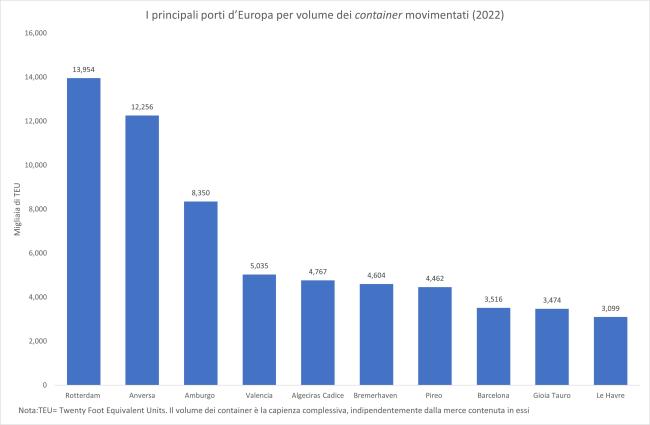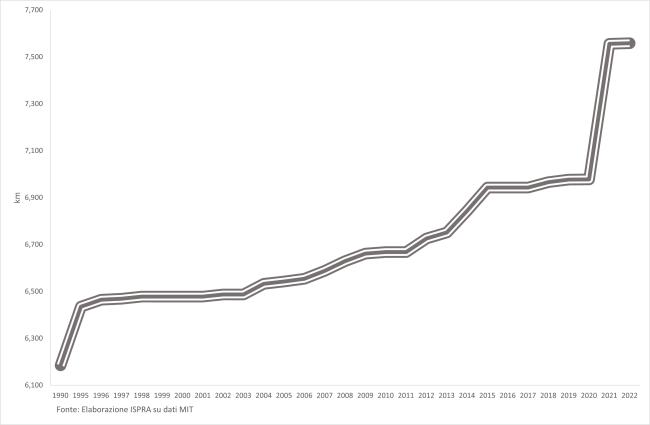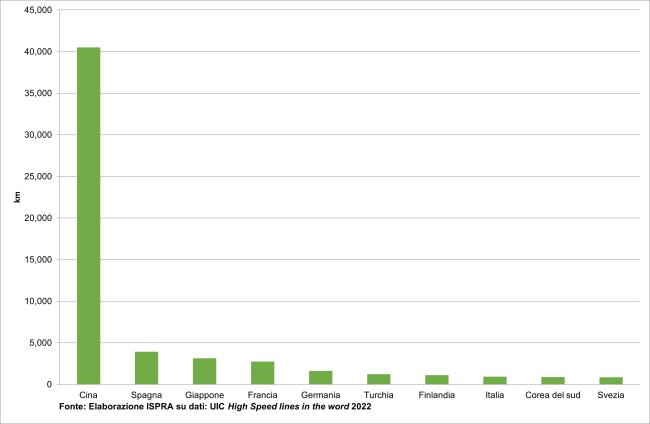Panel 1
Marina Colaiezzi
This indicator monitors the development of transport infrastructure networks. Between 1990 and 2022, 1,373 km of new motorways were constructed in Italy (+22.2%). As of 2022, Italy ranks eighth in the world for operational high-speed rail network length, according to the International Union of Railways (UIC).
The indicator assesses the availability and functionality of transport infrastructure across different modes. For road and rail transport, network infrastructures are considered, whereas for air and maritime transport, point infrastructures are taken into account. Transport infrastructure supports national and European markets and enhances social cohesion through accessibility. However, it can also contribute to social fragmentation, land use pressures, noise, and air pollution.
To monitor transport infrastructure networks in order to optimize their use and to revitalize certain modes, such as rail transport and urban fixed-track systems.
Starting with the new White Paper on Transport (28 March 2011), the European Commission outlined key objectives and challenges to be addressed. Among these objectives are: connecting transport networks (rail, airport, maritime, and inland waterways), upgrading infrastructure, and creating a single European airspace with a common aviation regulation framework.
In 2013, the EU adopted Regulation (EU) No 1315/2013 to enhance transport development within the EU, focusing on the Trans-European Transport Network (TEN-T). The regulation introduced two network concepts: the comprehensive network (to be completed by 2050) aiming for EU-wide accessibility and connectivity, and the core network (to be completed by 2030) consisting of the most crucial components of the comprehensive network.
More recently, in April 2021, the Italian Parliament approved the National Recovery and Resilience Plan (NRRP). In particular, Mission 3: Infrastructure for Sustainable Mobility aims to modernize, digitize, and make the national infrastructure system more sustainable by 2026. The goal is to meet the decarbonization targets outlined by the European Union in the framework of the European Green Deal and its related Strategy for Sustainable and Smart Mobility (published on 9 December 2020), and to align with the Sustainable Development Goals of the United Nations’ 2030 Agenda.
Mission 3 is divided into two components:
-
Rail Network Investments: focused on the development of Italy’s high-speed and high-capacity railway system, integration with regional rail services, and ensuring safety across the entire railway network. The primary objective is to enhance rail transport for both passengers and freight by increasing capacity and connectivity, improving service quality along key national and regional corridors, and strengthening cross-border links.
-
Intermodality and Integrated Logistics: includes measures to support the modernization and digitalization of the logistics system.
Additionally, aligned with the strategic framework of Mission 3 and financed through national resources, further investments will be implemented, including:
-
Road Safety 4.0: to enhance the safety and climate/seismic resilience of bridges and viaducts using technological innovation and climate change adaptation approaches.
-
Port system development: to increase the competitiveness, capacity, and productivity of Italian ports, with a focus on reducing pollutant emissions.
-
Strengthening regional rail services: further interventions will be carried out to improve regional railway transport.
Panel 2
Conto Nazionale delle Infrastrutture e della Mobilità Sostenibili 2022-2023, https://www.mit.gov.it/comunicazione/pubblicazioni
Rete ferroviaria italiana https://www.rfi.it/it/rete/la-rete-oggi/La_rete_oggi_regione_per_regione.html
Eurostat, Transport statistics, https://ec.europa.eu/eurostat/data/database, https://assaeroporti.com/
A limitation lies in the fact that the length of a transport infrastructure (e.g., highway, railway, etc.) only serves as a proxy indicator of its capacity. In reality, capacity should be measured by the maximum traffic flow the infrastructure can sustain, but this data is currently unavailable.
-
Data quality assessment
-
AISCAT – Italian Association of Motorway and Tunnel Concessionaire Companies
-
EUROSTAT – Statistical Office of the European Communities
-
ISTAT – Italian National Institute of Statistics
-
MIT – Ministry of Infrastructure and Transport (Italy)
-
RFI – Italian Railway Network
-
UIC – International Union of Railways
MIT- Conto Nazionale delle Infrastrutture e della Mobilità Sostenibili 2022-2023 Aiscat-Informazioni Eurostat-Db https://ec.europa.eu/eurostat/data/database?node_code=hlth UIC https://uic.org/passenger/highspeed/high-speed-database-maps RFI https://www.rfi.it/it/rete/la-rete-oggi.html ASSAEROPORTI https://assaeroporti.com/dati-annuali/
National; Regional
1990-2022/2023
Indicator assessment
For road networks, railways, metro systems, funiculars, and both urban and interurban tramways, length in kilometers was considered. For ports, the following metrics were used: the number of ports per province, the number of berths, and the number of ports equipped with rail tracks connected to the railway network. Additionally, the total surface area of storage yards and tanks for petroleum products and other liquids (in m²) was included. Finally, container volume and passenger traffic (arrivals and departures) were analyzed for major European ports.
As of 2022, the primary road network in Italy includes motorways (7,558 km), regional and provincial roads (132,234 km), and other roads of national interest (30,045 km), for a total extension of 169,837 km. The motorway network has remained almost unchanged compared to the previous year, with an increase of 1,373 km compared to 1990 (Table 1).
Regarding maritime transport infrastructure (as of 30 September 2023), there are 283 ports—many of which are small in size—with a total of 2,488 berths, corresponding to an overall quay length of approximately 511 km. Of these, only 216 are equipped with rail tracks connected to the railway network (Table 3).
In the aviation sector, there are 41 airports in Italy open to commercial traffic (certified by ENAC). Among the 20 Italian regions, only Molise and Basilicata lack airports (Table 5).
According to data from the Ministry of Infrastructure and Transport (MIT), the total length of the Italian railway network amounts to 16,829 km, of which 4,645 km are non-electrified (Table 1). Italy ranks 19th globally for total high-speed rail length (including planned/under-construction lines) and 8th for operational HSR lines (Table 6 and Figure 3).
An efficient and sustainable transport system is crucial for connecting regions and countries, as it links markets and people while supporting economic activity, development, and growth. In this context,Italy's current transport infrastructure system exhibits uneven spatial distribution in both road/highway and rail networks, with a clear disparity between Northern and Southern Italy in terms of network length (Table 2).
Regarding passenger rail systems—the country's primary transport infrastructure—the high-speed rail (HSR) network currently terminates at Naples/Salerno. Consequently, populations beyond this segment remain disconnected from the HSR system. This issue also affects Central Italy, where enhanced East-West rail connections are needed to provide inland communities with access to modern rail infrastructure. Further development of the still-limited metro network is also required, while construction is underway on infrastructure components needed to complete the core TEN-T network by 2030.
Data
Table 1: Inland passenger traffic in Italy, by mode of transport
Conto Nazionale delle Infrastrutture e dei Trasporti (CNIT) 2022-2023, MIT
-
Until 1980, the data also include the elevators of Genoa and Bergamo. Starting from 1985, the Vicenza interurban tramway was closed, and the “Adda” lines of Milan's ATM are considered as metro lines.
-
Since 1985, the “Adda” lines of Milan's ATM have been included.
-
Until 1980, the data are estimated and include the funicular of Trieste’s ACT, considered as a tramway. Starting in 2002, the series no longer includes the data from the elevators of Genoa, making the data non-comparable with those from previous years. The Mercogliano-Montevergine (AV) system was closed for operation starting from 12/10/2012 and reopened on 25/06/2016.
Table 2: Road and Railway Networks by Region – Road Network Density Indicators
Processing by the Ministry of Infrastructure based on data from AISCAT, ANAS, ISTAT, and direct surveys conducted with Regions and Provinces. Processing by ISPRA based on data from ISTAT and RFI – Italian Railway Network (https://www.rfi.it/en/network/the-network-today/The_network_today_by_region.html)
TABLE 3: PORT INFRASTRUCTURE ASSETS AND CAPACITY IN ITALY (AS OF 30/09/2023)
Source: Ministry of Infrastructure and Transport (MIT), Harbour Master's Offices, Port System Authorities.
-
Mq = square meters
-
mc = cubic meters
TABLE 4: TOP EUROPEAN PORTS BY CONTAINER VOLUME AND PASSENGER TRAFFIC (ARRIVALS + DEPARTURES)
Eurostat, Transport statistics (Last updated 04/12/2023 for container volume and 03/09/2024 for passenger traffic)
1 TEU = Twenty Foot Equivalent Unit. The container volume refers to the total capacity, regardless of the type of goods contained within
Table 5: Main Technical Characteristics of Italian Airports Certified by ENAC – January–December 2023
Ministry of Infrastructure and Transport, based on provisional data from ENAC – ASSAEROPORTI
https://assaeroporti.com/archivio/
https://www.enac.gov.it/aeroporti/infrastrutture-aeroportuali/dati-di-traffico
Commercial air traffic (international and domestic) refers to the transport of passengers or cargo for remuneration. It includes scheduled services, charter flights, and air taxis. "Movements" refers to the total of arrivals and departures. "Passengers" include both arriving and departing individuals at each airport. "Cargo" includes freight and mail.
-
n.d.: not available
-
n.a.: not applicable
Table 6: High-Speed Rail Lines Worldwide, 2022 (updated October 2023)
Source: UIC - International Union of Railways (website: https://uic.org/passenger/highspeed/article/high-speed-data-and-atlas)
-
In operation: currently operational as a high-speed rail line;
-
Under construction: high-speed rail line currently being built;
-
Planned: officially approved, but construction has not yet started;
-
Long-term planning: not yet approved, but included in long-term development plans.
Source: Eurostat, Transport Statistics (latest available update: 04/12/2023 for container throughput volume)
1 TEU = Twenty-Foot Equivalent Unit. Container volume refers to total capacity, regardless of the type or value of the goods contained.



During the period 1990-2022, the length of road infrastructure (excluding municipal roads) increased by 13.7%. In 2022, the railway network extended over 16,829 km, comprising 12,184 km of electrified network (+24 km compared to 2021) and 4,645 km of non-electrified network. The total extension of urban and suburban tram networks in 2022 was 421 km, while the metro network length remained relatively modest at approximately 215 km. Terrestrial funicular railways, essential for transportation along steep gradients, are operated in Italy by 19 companies, with a total operational length of 21 km. While primarily serving tourist needs, they often facilitate daily commuting for local residents (Table 1).
In 2022, half of the major European ports listed in Table 4 showed positive growth in cargo traffic compared to 2020, with Le Havre recording a 42.8% increase. Rotterdam, handling approximately 14 million TEU in 2022 (15 million in 2021), remained Europe's largest container port by volume, followed by Antwerp (12.3 million TEU in 2022) and Hamburg (8.4 million TEU in 2022, compared to 8.8 million in 2021) (Table 4 and Figure 1). Gioia Tauro ranked ninth with 3.5 million TEU in 2022 (3.4 million in 2021) (Table 4).
Regarding passenger traffic, all considered ports showed increased passenger flows compared to 2021, though only Paloukia Salamina and Peramas reached 2019 levels. The top three ports by passenger volume were Messina (over 9 million in 2022 and 12 million in 2019), Reggio Calabria (approximately 9 million in 2022 and 12 million in 2019), and Piraeus (over 8 million in 2022 and 9 million in 2019) (Table 4).
For Italian airport infrastructure (Table 5), in 2023 Rome Fiumicino and Milan Malpensa had the largest areas (1,605 and 1,244 hectares, respectively) and the most extensive aircraft parking spaces (1,328,100 m² and 1,319,000 m², respectively).
As reported by Assaeroporti, Italian airports reached 197.2 million passengers in 2023, surpassing the 2019 pre-pandemic record by 2.1%. This recovery followed the pandemic period during which the airport system lost at least 280 million passengers.